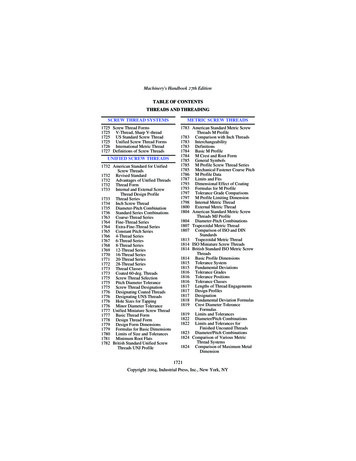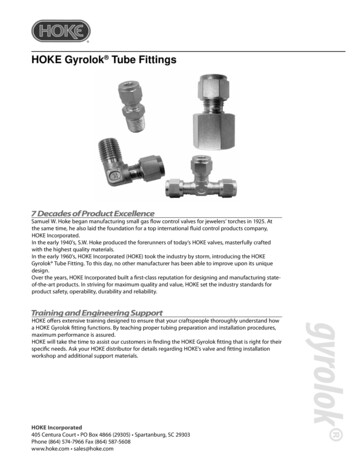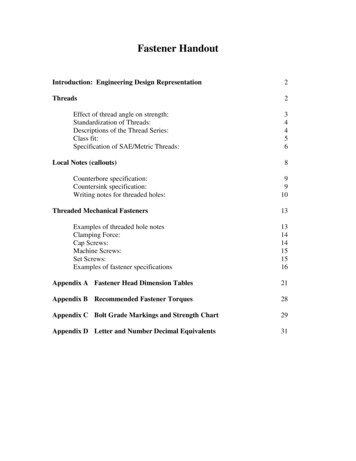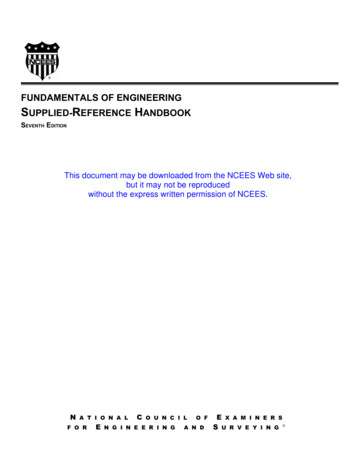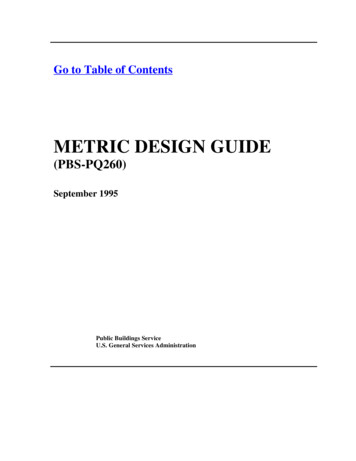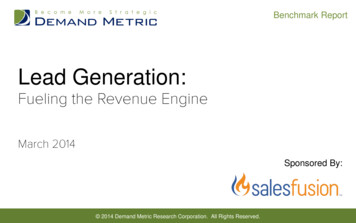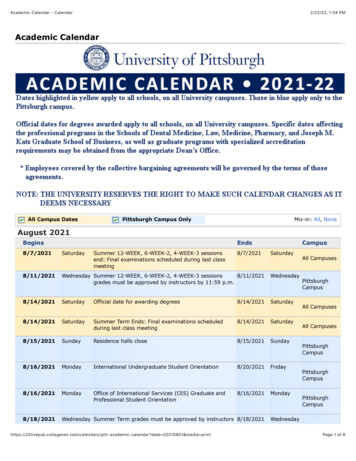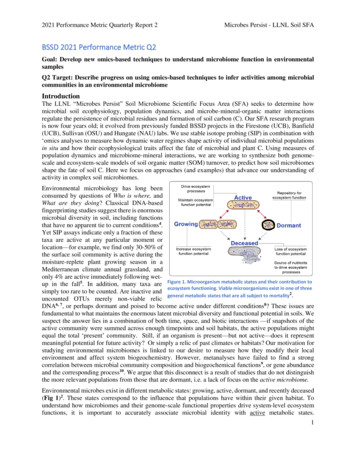
Transcription
2021 Performance Metric Quarterly Report 2Microbes Persist - LLNL Soil SFABSSD 2021 Performance Metric Q2Goal: Develop new omics-based techniques to understand microbiome function in environmentalsamplesQ2 Target: Describe progress on using omics-based techniques to infer activities among microbialcommunities in an environmental microbiomeIntroductionThe LLNL “Microbes Persist” Soil Microbiome Scientific Focus Area (SFA) seeks to determine howmicrobial soil ecophysiology, population dynamics, and microbe-mineral-organic matter interactionsregulate the persistence of microbial residues and formation of soil carbon (C). Our SFA research programis now four years old; it evolved from previously funded BSSD projects in the Firestone (UCB), Banfield(UCB), Sullivan (OSU) and Hungate (NAU) labs. We use stable isotope probing (SIP) in combination with‘omics analyses to measure how dynamic water regimes shape activity of individual microbial populationsin situ and how their ecophysiological traits affect the fate of microbial and plant C. Using measures ofpopulation dynamics and microbiome-mineral interactions, we are working to synthesize both genomescale and ecosystem-scale models of soil organic matter (SOM) turnover, to predict how soil microbiomesshape the fate of soil C. Here we focus on approaches (and examples) that advance our understanding ofactivity in complex soil microbiomes.Environmental microbiology has long beenconsumed by questions of Who is where, andWhat are they doing? Classical DNA-basedfingerprinting studies suggest there is enormousmicrobial diversity in soil, including functionsthat have no apparent tie to current conditions4.Yet SIP assays indicate only a fraction of thesetaxa are active at any particular moment orlocation—for example, we find only 30-50% ofthe surface soil community is active during themoisture-replete plant growing season in aMediterranean climate annual grassland, andonly 4% are active immediately following wetup in the fall5. In addition, many taxa are Figure 1. Microorganism metabolic states and their contribution toecosystem functioning. Viable microorganisms exist in one of threesimply too rare to be counted. Are inactive andgeneral metabolic states that are all subject to mortality2.uncounted OTUs merely non-viable relicDNA6, 7, or perhaps dormant and poised to become active under different conditions8? These issues arefundamental to what maintains the enormous latent microbial diversity and functional potential in soils. Wesuspect the answer lies in a combination of both time, space, and biotic interactions —if snapshots of theactive community were summed across enough timepoints and soil habitats, the active populations mightequal the total ‘present’ community. Still, if an organism is present—but not active—does it representmeaningful potential for future activity? Or simply a relic of past climates or habitats? Our motivation forstudying environmental microbiomes is linked to our desire to measure how they modify their localenvironment and affect system biogeochemistry. However, metanalyses have failed to find a strongcorrelation between microbial community composition and biogeochemical functions9, or gene abundanceand the corresponding process10. We argue that this disconnect is a result of studies that do not distinguishthe more relevant populations from those that are dormant, i.e. a lack of focus on the active microbiome.Environmental microbes exist in different metabolic states: growing, active, dormant, and recently deceased(Fig 1)2. These states correspond to the influence that populations have within their given habitat. Tounderstand how microbiomes and their genome-scale functional properties drive system-level ecosystemfunctions, it is important to accurately associate microbial identity with active metabolic states.1
2021 Performance Metric Quarterly Report 2Microbes Persist - LLNL Soil SFASimultaneous identification of active microbes, their genomic capacity, and metabolic states has been alongstanding goal in microbial ecology, and methods to achieve this have accumulated in our moleculartoolboxes—even for highly complex systems like soil. These methods include standard ‘omics approaches(amplicon fingerprinting, metagenomics, viromics, metatranscriptomics, metaproteomics, metabolomics,lipidomics), and SIP-enabled versions of these ‘omics tools11-14. In this report, we provide examples of howour SFA team has developed new understanding of microbiome activity using these tools.‘Omics techniques that infer activity16S rRNA as a measure of activityFor over a decade, researchers have used ribosomal RNA gene surveys (rRNA genes) to identifyenvironmental microorganisms present in a sample, and many studies measure ribosomal RNA (rRNA) asan indicator of growing or active taxa (e.g. 15-20). However, in a 2013 metanalysis, Blazewicz et al. foundconflicting patterns between rRNA content and growth rate2. Their work indicates that real-time activityand rRNA profiles in environmental samples do not always correlate due to differences in life histories, lifestrategies, and non-growth activities. Therefore, rRNA analysis may not be a reliable metric of currentlyactive microbial communities.Gene expression (metatranscriptomics)Unlike amplicon or metagenomic data, which only provide information about the functional potential of asample (not its current metabolic state), metatranscriptomic (mRNA) data comes one step closer toreflecting true microbial activity, albeit without providing direct evidence of translation or enzyme activity.Metatranscriptomics in soil remains a challenging approach—due in part to difficulty of extracting enoughhigh-quality mRNA, successfully depleting rRNA, and having an ideal reference database.Community mRNA responsetocarbonaddition:Microbial traits can beobserved at the genome level(inmetagenomes),butalterations in microbes a flexibility that ismuch greater than what wecan deduce from theirFigure 2. The concentration of nitrate (A) and the transcriptional response forgenomictraits.Theseinorganic nitrogen transporters (B) following the addition of labile carbon to analterations in response toagricultural soil in a laboratory incubation.environment changes happenquickly. We studied the short-term response of soil microbes to a change in C availability by addingglucose. We took samples before and 8, 24 and 48 h after glucose addition, extracted DNA and RNA, andsequenced and assembled the metagenomes and metatranscriptomes22. Within 8 h after glucose addition,very large changes in microbial N cycling occurred: transcript abundances for nitrate uptake, reduction toammonium and assimilation increased 32 to 250-fold, while transcripts for the enzymes for nitrificationand denitrification decreased (Fig 2)23. This research shows that in combination, metagenomes andmetatranscriptomes are powerful in helping understand microbial functions relevant to soil health at afoundational biochemical level.In a second study, we examined transcript abundances of inorganic nutrient transporters (N, P, K, Ca, Mg,S, Cl, Cu, Fe, Mn, Mo, Ni and Zn; Dijkstra et al in prep), again in combination with a soil glucose addition(Fig 3). Before glucose addition, transcripts for iron transport systems were particularly abundant, whileafter glucose addition, the ammonium, nitrate/nitrite and urea transporters increased dramatically,becoming the most abundant transporter transcripts. Transcript profiles of nutrient transporters before2
2021 Performance Metric Quarterly Report 2Microbes Persist - LLNL Soil SFAglucose addition were similar to those measured in a range of soil,freshwater and marine ecosystems. Interestingly, while transcriptabundances (mRNA) changed rapidly following the glucoseaddition, overall gene abundances (from DNA) remained the same.This research shows that alterations in gene-expression allowmicrobes to respond to their environment in the short-term byaltering their ecophysiological traits and suggests thatmetatranscriptomes are a far more relevant read-out of the currentactivity occurring within a microbiome than surveys of taxonomicabundance (amplicons) or genomic potential (metagenomes).Using gene expression to identify rhizosphere decomposer guilds:Soil resource availability also changes quickly in the soil Figure 3. Transcript abundances ofsurrounding roots (rhizosphere). Stimulated by exudates and rootinorganic nutrient transporters changedecay, rhizosphere organisms interact to break down C derived from within 8 h after a soil glucose addition,while the gene abundances remainroot tissues and move it into the surrounding soil, ultimatelyregulating how soil C is stabilized or lost. However, the microbial constant. (Dijkstra et al., in prep.)mechanisms that underpin rhizosphere C cycling are poorly understood. We analyzed time-resolvedmetatranscriptomes to compare microbial functions in rhizosphere, detritusphere, and combinedrhizosphere-detritusphere habitats3. Aggregated population transcripts were binned using a customreference database generated from soil isolate genomes, single cell amplified genomes, metagenomes, andSIP metagenomes24. Our results helped to identify distinct groups (‘guilds’) of microbes that expresscarbohydrate active enzyme (CAZy) genes in a spatially or temporally coherent manner. We show thatthese guilds have a cohesive metabolic niche within the rapidly changing rhizosphere environment. Whilethesoilhabitatsignificantly affected bothcommunity compositionandoverallgeneexpression,thesuccession of microbialfunctions(genetranscripts) occurred at afaster time scale thancompositionalchanges(Fig 4A,B). Our study isone of the first in soils toexplainhownichedifferentiationoccurs,and to map ation-resolved geneexpression (Fig 4C).Genome-centric analyseslike these allow us to tracktranscription in individualpopulations, which may be Figure 4. NMDS ordinations show the influence of time on 16S bacterial communities (A)a more relevant approach and mRNA transcripts (B) during 22 days of plant root growth. (C) Number of functionallythan grouping transcripts active taxa by soil habitat relative to the total metagenomic capacity. The outer circleacross disparate classes or (brown) indicates the number of unique genomes in our reference database with genomicpotential for the specified gene class; inner circles reflect the number of taxa thatphyla.differentially upregulated each gene class, per treatment.3
2021 Performance Metric Quarterly Report 2Microbes Persist - LLNL Soil SFANitrogen cycle activities: In thesame metatranscriptome datasetdescribed above, we are alsoanalyzing genes involved in Ncycle processes. Most soil N isembedded in complex organicmolecules such as proteins, chitin,DNA and lipids. However, plantscan only take up N that is eitherinorganic or in small organicmolecules (e.g. amino acids).Thus, degradation of complex Nmolecules by soil bacteria is alimiting step in plant Nacquisition, but it is unknownwhich bacteria actualize theirgenomic potential to participate inN mineralization. We find Figure 5. Expression of extracellular proteases in bulk and rhizosphere soils fromextracellular proteases are among common wild oat Avena fatua microcosms, grown without root litter amendmentthe most highly expressed N (A), or with litter amendment (B); expression of chitinase gene chit1 (C) and meancycling genes in our soils (Fig 5). counts of chitinases at the domain level (D).The taxonomy of the bacteria expressing these proteases varies with time and soil habitat (rhizosphere, bulksoil, litter amended), suggesting that a succession of different bacteria affect plant-available N throughoutplant growth. While chitinase was not as highly expressed as protease, it was significantly correlated withthe presence of root litter, which may be because litter attracts fungi and other chitinous organisms.In an inclusive analysis of all the expressed genesinvolved in organic and inorganic N cycle processes,we find that the presence of litter and/or living rootssignificantly alters the trajectory of N cycling geneexpression (Fig 6). Expression (normalized tosequencing depth and gene length) was highest forammonia monooxygenase subunits amoAC, nitratereductase nirK, glutamate synthase glnA andextracellular proteases (exoprotease). Ammoniumoxidation gene expression was almost exclusivelyperformed by archaea and downregulated in therhizosphere. Glutamate synthase expression patterns (akey indicator of ammonium assimilation via theGS/GOGAT pathway during N-limited conditions)suggest N limitation occurred during early rhizospheredevelopment as well as in bulk soils that had beenamended with root litter. Assimilatory nitrate reductionand ammonium assimilation were upregulated in therhizosphere, whereas dissimilatory nitrate reductionand chitinase were upregulated in the detritusphere.Overall, these transcript expression patterns revealdominant processes may be carried out by lowabundance microorganisms and N transformationspatterns that were not reflected in communitycomposition data.Figure 6. Expression level and upregulation of N cycling ORFsfrom assembled transcripts. Bold font indicates statisticallysignificant expression. Numbers denote pathways:1 ammonia oxidation, 2 nitrite oxidation, 3 assimilatorynitratereduction,4 denitrification,5 Anammox,6 nitrogen fixation, 7 DNRA, 8 ammonia assimilation(GDH and GS/GOGAT), 9 macromolecular N mineralization.4
2021 Performance Metric Quarterly Report 2Microbes Persist - LLNL Soil SFAMetabolomics and LipidomicsIn soil, the diverse array of metabolites and microbial taxamake it challenging to directly assess the functionalassociations between metabolites and microorganismsunder different conditions, unless individual isolategenomes are available25. Still, after transcriptomics andproteomics, metabolomics comes a step closer toreflecting the active metabolic state of a microbiome. Ifchanges in functionally associated metabolites andmicrobial taxa are tightly bound, the alteration of one pool(e.g. in response to changing abiotic conditions) should bereflected in changes of the other. Soil metabolites can bemeasured several ways; here we describe results collectedwith LC-MS-MS and Fourier-transform ion cyclotronresonance-mass spectrometry (FTICR-MS).Active VirusesAmplicon and metagenome surveys includemany soil organisms that are inactive. Butare viral sequences different? Does viralDNA have an inherently shorter half-life?i.e., when we identify viral sequences, canwe infer they are active? A serendipitousfinding in our mRNA dataset is a diversityof RNA viral genomes1 that we mapped toour site-specific metagenome3. Based onthe phylogeny of the identified RNAviruses, it appears that most of them targetfungal hosts.Rhizosphere LC-MS-MS metabolites:Elevated CO2 (eCO2) studies provide a unique opportunity to assess effects of altered root exudate(metabolite) patterns on microbial community succession and function, since eCO2 stimulates higher ratesof photosynthesis, increased belowground biomassproduction, and soil deposition of labile C26, 27. Inour research on root-soil interfaces, we have foundthat plants grown under elevated (700 ppm) CO2increased both C allocated belowground and theamount of root-derived 13C in the mineralassociated fraction28. Metabolites produced in earlyweeks of plant growth under eCO2 conditionsclustered distinctly from “later” producedmetabolites (Fig 7). Since eCO2 both increased anddecreased specific exudate components (Fig 7),additional work is needed to parse how thesechanges map to the active microbiome in the soils.Our team has also been working to substantiate themolecular formulae assigned and identify knownmetabolites using LC-MS/MS based approaches.We are using MS/MS based molecular networkanalysis to relate unknown components of soilorganic matter to each other, and to knowncompounds, via the similarity of theirfragmentation spectra. In this way, molecules canbe grouped into more finely classified familieswhere detailed structural differences can bedetected and ultimately used to expand the numberof known molecules in soils.Figure 7. Heat maps of metabolites from an experimentwhere A. barbata was grown with eCO2 for 9 weeks. A. Rootexudate profiles for the 25 most common metabolites.Warm colors reflect higher abundance. B. Metabolite heatmap for root exudates that were significantly differentbetween eCO2 and ambient CO2 treatments.Soil organic matter characterization with FTICR-MS:Molecular formula assignment, made possible by the high-resolution mass accuracy of FTICR-MS, hasbrought this tool to the forefront for untargeted investigation of soil metabolites and dissolved organiccarbon (DOC) composition. The molecular composition of soil organic carbon (SOC) is a strongdeterminant for whether it is consumed, modified, or left untouched by microbial decomposers. Hence, theinformation gathered from formula assignments can help identify the type and amount of microbial activity5
2021 Performance Metric Quarterly Report 2Microbes Persist - LLNL Soil SFAin soil. For FTICR-MS, soils aretypically sequentially extractedusing water, methanol, thenchloroform to capture polar andnonpolar soil metabolites29 andthen analyzed. We have used thisapproach for multiple studies,including one where tropical soilwas incubated under static andoscillating soil redox conditions todetermine the effect of O2availability on soil C pools. TheFTICR-MSmetabolitedatasuggest that redox conditionssignificantly impacted soil Ccomposition (Fig 8). Specifically,fluctuating and oxic treatments Figure 8. Impacts of redox conditions on water extractable soil metabolites inhad more dynamic metabolite soils incubated under static oxic or anoxic conditions, or two oscillatingprofiles, while the anoxic treatments (low freq., high freq.) for 44 days (Campbell, Pett-Ridge et al. in prep)treatment changed less. Soils kept under static anoxic conditions had more amino sugars, carbohydrates,lignin, proteins, and tannins, and less unsaturated hydrocarbons, than oxic or oscillating soils.In a related study, we found that more labile, oxidized substrates released from fresh plant litter were equallydepleted by both anaerobic and aerobic heterotrophs30. However, the conversion of more reduced, lessthermodynamically favorable SOC to CO2 primarily happened under aerobic conditions. This nuance in thebehavior of microbes actively consuming different types of C under varying redox conditions will be animportant addition to improve predictive models of C fluxes in tropical forest soils.Soil lipidomics:Minerals preserve the oldest most persistent soil C andplay a critical role as a microbial habitat. In a recentstudy, we incubated four different mineral types(ferrihydrite, kaolinite, quartz, and density fractionatedminerals) in the rhizosphere of 13C-labeled plants.Distinct bacteria and fungi colonized the differentmineral surfaces and had distinct capacities for rapidgrowth; their ribosomal copy number was significantlycorrelated with relative isotope enrichment onminerals31. We then used lipidomics (at EMSL) to traceplant- versus microbial-derived C onto minerals,characterizing total C, 13C enrichment, and SOCchemistry32. Many of the mineral-associated lipids thatwe found were microbially-derived, including a largefraction of fungal lipids (Fig 9). Microbial assimilationof SOC compounds may result in transformation ofthose compounds to lipids as microbes synthesize theirmembranes and storage lipids. The lipidomicstechnique could prove to be a powerful connectionbetween microbiome ecophysiology and SOCchemistry, especially if it becomes more possible to Figure 9. A heatmap comparing log10 transformed lipiddirectly link specific lipid classes to microbial intensities for lipids identified in bulk and rhizospheresoil, by mineral type.phylotypes.6
2021 Performance Metric Quarterly Report 2Microbes Persist - LLNL Soil SFAStable Isotope ProbingStable isotope probing (SIP) is one of the few approaches that can identify the ecophysiology of activemicroorganisms in their native environments, making it one of the most powerful techniques in microbialecology. Broadly speaking, SIP refers to any technique where microorganisms that have actively consumedsubstrates enriched in rare stable isotopes (e.g. 13C, 15N, 18O) are identified based on the resulting isotopicenrichment of their nucleic acids, proteins, and metabolites. Density gradient SIP is the culture-independentgold standard for directly linking sequence to function in complex microbial communities 33. When amicroorganism consumes a substrate enriched or “labeled” with a heavy isotope, the cellular componentsof that cell also become labeled in the heavy isotope. Density gradient SIP takes advantage of the increaseddensity of microbial nucleic acids (due to assimilation of heavy isotopes), using a density gradient toseparate the heavy (labeled) nucleic acids from lighter (unlabeled) ones. Isolated heavy nucleic acids canthen be characterized to identify the organisms that actively assimilated substrates of interest.Our SFA team has pioneered new SIP methods that quantify element fluxes with high taxonomic resolution.In particular, quantitative stable isotope probing or qSIP, developed at NAU, is the isopycnic separation ofnucleic acids in cesium chloride combined with a mathematical model to quantify isotope enrichment 11, 3437. With qSIP we measure growth rates of individual taxa in complex soil communities using 18O-labeledwater as a universal substrate that is used by all actively growing organisms. qSIP is also applicable tometagenomic and viromics analyses, as we describe below.16S rRNA gene targeted SIPTaxon-specific growth following soil rewetting:Microbial activity is stimulated by the rewetting of dry soils, resulting in a pulse of C mineralization andnutrient availability. While there has been much interest in the response of indigenous communities to soilwet-up, until our 2020 paper on the subject5, no work had identified the specific microorganisms in semiarid soils that grow in response to soil wet-up. We used heavy water (H218O) DNA SIP coupled with highthroughput sequencing of bacterial 16S rRNA genes to characterize taxon-specific growth activitiesfollowing the rewetting of a seasonally dried California annual grassland soil. We hypothesized that afteran abrupt change in soil water potential due to wetting of dry soil, new growth would follow a sequentialresponse pattern due to differences in growth strategies. Using qSIP, bacterial growth was detectable withinthe first three hours after wet-up (Fig 10), and approximately 40% of the measured taxa were found to begrowing during the 7-day incubation. At the genus level, bacteria exhibited different growth rate responseFigure 10. a-c) Examples of taxon-specific growth rate response patterns (a primary, b secondary, c tertiary). Delayedresponders are not shown because most of these taxa only grew at the final timepoint. d) Correlation between the portionof CO2 produced vs. community growth rate. e,f) Phylum level growth rates for (e) 100% and (F) 50% precipitationtreatments following wet-up, calculated with qSIP.7
2021 Performance Metric Quarterly Report 2Microbes Persist - LLNL Soil SFApatterns, with growth rate curves representing four potential responses (Fig 10a-c). Average communitygrowth rate was well-correlated with the proportion of total CO2 released at each time period (Fig 10d),indicating that even in complex microbial communities, population dynamics can translate quantitativelyto ecosystem-scale biogeochemistry. Since the biological predictors of this CO2 pulse are challenging toidentify, it is exciting to observe a clear linear relationship between microbial growth rate and CO2 efflux.In the fall of 2018, we performed a second 18O-water SIP wet-up experiment designed to ask how reducedspring rainfall affects the amount of C subsequently lost after re-wetting and phage-driven bacterialmortality. After the annual summer dry period, we wet soils with 18O-water and harvested at six times (0,3, 24, 48, 72, 168 h). Using 16S rRNA qSIP, we see that spring precipitation treatment differences do affectsubsequent microbial growth rates during the fall wet-up (Fig 10e,f). Overall, growth began more rapidlyand was sustained at higher rates in 100% precipitation soils. These results suggest a soil’s historic rainfallpatterns significantly impact microbial activities, turnover, and persistence.16S qSIP highlights taxon-specific response to changing redox periodicity:We have also used 16S rRNA qSIP to characterize the active soil microbiome in our tropical soil redoxstudies. In many wet tropical forest soils, fluctuating redox conditions support a metabolically diversemicrobial community that mediates C turnover and critical ecosystem processes. However, global climatechange is causing less regular rainfall at tropical latitudes and may lead to inconsistent soil redox periodicityin these systems. We conducted an incubation with 13C-enriched plant litter to distinguish the microbialconsumers of fresh plant litter versus native soil organic matter under different redox regimes in a tropicalforest soil30, 38. 13C qSIP provided evidence for phylogenetically conserved trends in microbial Cassimilation from plant litter. Most notably, bacteria from the phylum Firmicutes assimilated proportionallymore litter C under static anoxic conditions (Fig 11a). Several taxa derived a substantial portion of theirnucleic acid C from litter regardless of soil redox status, indicating that facultative metabolisms arerelatively common in this naturally O2 dynamic environment. Surprisingly, many of the taxa that derivedthe highest proportion of their nucleic acid C from litter were not abundant, suggesting that ‘rare’ organismsmay play an important role in terrestrial C cycling (Fig 11b). 13C qSIP revealed aspects of microbial activityand litter C assimilation that were not apparent from our traditional 16S rRNA community analyses. Alongwith our biogeochemical measurements, these findings show that microbial response to shifting redoxperiodicity influences C cycling in tropical forest soils.Figure 11. (A) Taxon-specific litter C assimilation of three phyla (shown as 13C atom fraction excess) following 44 days ofincubation under four different redox regimes. Each point represents the 13C enrichment of a bacterial or archaeal ASV(amplicon sequence variant). (B) Taxon-specific litter C assimilation of all taxa identified as active by qSIP (shown as 13C atomfraction excess) following 44 days of incubation under different redox regimes. Colors reflect the same phyla as in (A). (Hestrin,Pett-Ridge et al. in prep)SIP-identified bacterial predators:Stable isotope probing is ideally suited to studies of cross-kingdom interactions and food webs. Predationhelps structure food webs and the flow of nutrients through systems. By studying environmental predators8
2021 Performance Metric Quarterly Report 2Microbes Persist - LLNL Soil SFA18Characterizing the total vs active soil microbiome with SIP:We characterized the present (total) vs. growing (active) soil bacterialand archaeal communities in three California Mediterranean grasslandsusing heavy water SIP 16S rRNA amplicons. While the sites span amean annual rainfall gradient (383 mm yr-1 to 2160 mm yr-1), weconducted our study during the spring season when soil water contentwas similar between sites and not limiting. Richness and Shannon’sdiversity index did not vary between sites for the present microbialcommunities (measured by 16S rRNA amplicon sequencing), but thediversity of actively growing microorganisms was higher in theintermediate site than the wettest site. Despite similar environmentalconditions leading up to the incubation, mean relative growth rates werelowest at the driest site. The growth rate of a bacterial taxon in one siteexplained up to 57% of the variation in that same taxon’s growth rate inanother site (Fig 13), suggesting that cross-site variation in communitymean growth rate is influenced by evolutionary history of the taxa ateach site. Low relative growth rates in soils from the driest site mayreflect a tradeoff between traits that allow microorganisms to survivechronic drought and maximum potential growth rate.O FME Hoplandthrough the lens of stable isotope probing (SIP) we can begin to identify theimpact of these predators. Analyzing the growth of soil bacteria with qSIP, wefound that predatory bacteria grew more and faster than non-predatory bacteria(Fig 12). This indicated that they were consuming a large amount of C fromnon-predatory bacteria and could have a large influence on the ecology andnutrient flow through soil. After finding isotopically enriched Bdellovibriosequences in several of our datasets, we hypothesized that bacterial predationis a significant driver of soil microbial mortality. Predatory bacteria arecommon in nature, yet their roles in soil microbial food webs are poorlyknown. We used meta-analysis to synthesize H218O SIP measurements from81 experiments conducted at 14 sites--nearly 100,000 taxon-specific estimatesof in situ bacterial growth rates39. Growth rates of predatory bacteria were 19%higher than for non-predatory bacteria, and especially high for obligatepredators in the Vampirovibrionales and in the genus Lysobacter, which arecapable of gliding motility and known to exhibit wolfpack hunting behavior4042. Added C substrates disproportionately stimulated growth rates of obligateFigure 12. Relative difference in predator growth rate predators compared to non-predators and facultative(A) and 13C uptake rate (B) compared to non- predators. These qSIP findings support the ecologicalpredators. Values are shown separately for facultative th
scale and ecosystem-scale models of soil organic matter (SOM) turnover, to predict how soil microbiomes shape the fate of soil C. Here we focus on approaches (and examples) that advance our understanding of activity in complex soil microbiomes. Environmental microbiology has long been consumed by questions of Who is where, and
